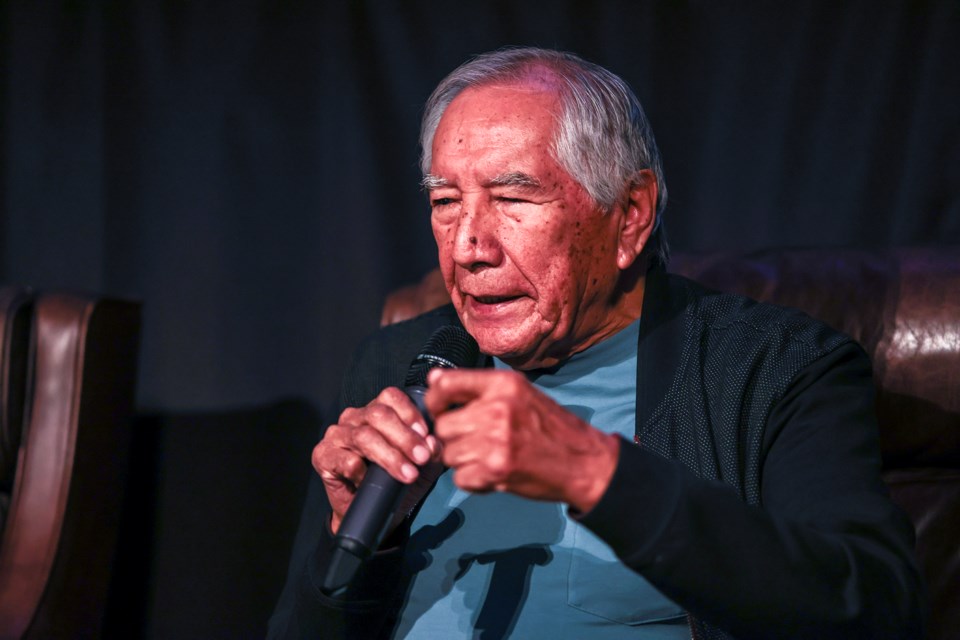BANFF – “I can say, ‘I am buffalo. I am the environment.’ There’s no separation between us and them or other. We really believe that’s true,” said Amethyst First Rider.
In Iniskim – Return of the Buffalo, First Rider, a member of the Blood Tribe of the Blackfoot Confederacy, reflects on a worldview where humans and nature are interconnected and inseparable. This core belief in many Indigenous cultures sees the land, animals and people as parts of a whole rather than distinct identities.
The documentary celebrates the story of bison returning to Banff National Park as part of the 2017 reintroduction project – brought to life with a dazzling display of lantern puppets against the inky dark of night.
“Working on these buffalo lanterns, you are the buffalo; you become the buffalo,” said First Rider. “Each movement of your hands, each connection, each dream – you’re creating energy as you make them, and as you imbue them, they become a part of you.”
The puppet performance, narrated from Indigenous perspectives and developed in 2017, was adapted into a documentary to extend its reach to a broader audience while perpetuating the celebration of the bison’s reintroduction to Banff that same year, lauded as a triumph in conservation efforts.
Absent from Banff National Park for 160 years, bison – considered a keystone species – have made a successful return. Starting with 16 translocated plains bison from Elk Island National Park, including 10 young females and six young males, the herd has flourished. With 20 calves born last spring, it now boasts a population of over 100.
The reintroduction of the animal to the area involved extensive planning and coordination, beginning years ago with conversations about its significance in Indigenous culture.
In 2014, First Rider and her husband, renowned academic Leroy Little Bear, were instrumental in organizing the Buffalo Treaty – a groundbreaking agreement signed by various First Nations in southern Alberta and Montana to honour, revitalize and protect the time-honoured relationship with the animal.
The treaty seeks to re-establish the animal as a vital part of the ecological system and cultural heritage across historic First Nations’ homelands, transcending the borders between the United States and Canada. It underscores the interconnectedness of humans, buffalo and the environment, aiming to nurture a future where buffalo and First Nations thrive together, culturally, spiritually and ecologically.
In 2015, Goodstoney and Chiniki First Nations also signed on at a special treaty convention in Banff, along with Samson Cree First Nation. Another eight First Nations signed in 2016.
The treaty ultimately became a pathway, uniting various people and organizations under the shared goal of reintroducing bison to the great plains of North America, where it once roamed in numbers of upwards of 30 million before over-hunting pushed the animal to the brink of extinction.
For Parks Canada, Indigenous involvement in its reintroduction plan was crucial. This collective, guided by treaty, provided invaluable guidance for finalizing its approach.
Since 2014, the Buffalo Treaty has garnered over 50 signatories, including post-secondary institutions like the University of Lethbridge and Lethbridge College. The treaty celebrates its 10th anniversary in September.
Much like the treaty itself, Iniskim – Return of the Buffalo is a display of interrelations.
Its cast and creators comprise Indigenous and non-Indigenous peoples, working together to share the narrative of bringing back the animal, its stories and its songs. All of the film’s music is composed by Anders Hunter of Bearspaw First Nation and performed by drum group Eya-Hey Nakoda – its members are predominately Îyârhe Nakoda from the Bearspaw, Chiniki and Goodstoney First Nations.
“I think what inspires is that, for all of us, we’ve lived this story. Each one of us are part of that story. We had singers come in, we had drummers, we had storytellers, masters of puppetry, and I think that each and every one of us brought an experience to that,” said First Rider.
She said she hopes the film inspires the Indigenous community to get more involved in filmmaking, storytelling and art.
“I think we’re just hitting that stride, so I look forward to many beautiful works in the future.”
Screening Iniskim – Return of the Buffalo was part of the Banff Centre for Arts and Creativity’s programming for National Indigenous History Month in June. Other upcoming events include a concert featuring Afro-Indigenous hip-hop and R&B artist Jah’kota at the Jenny Belzberg Theatre on June 21, National Indigenous Peoples Day.
On June 26, in partnership with Banff Centre, Canmore’s artsPlace will host an evening of short films created by Indigenous filmmakers Janine Windolph and the Nakoda AV Club. From June 21-30, various Indigenous short films will also be available to watch for free online at www.banffcentre.ca.
The Local Journalism Initiative is funded by the Government of Canada. The position covers Îyârhe (Stoney) Nakoda First Nation and Kananaskis Country.




